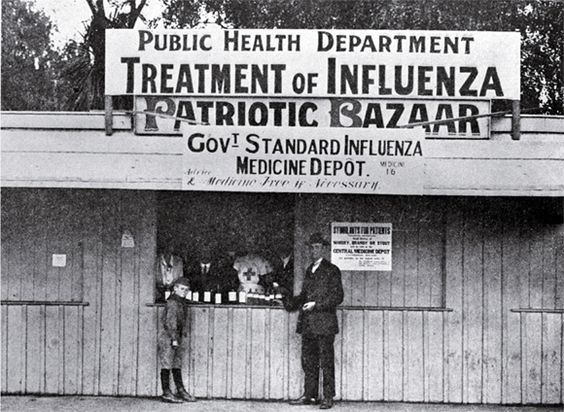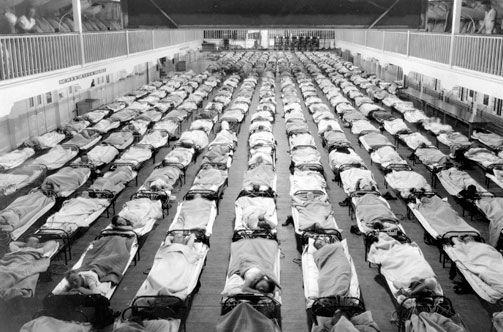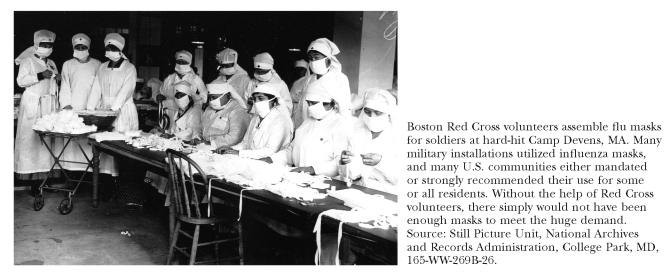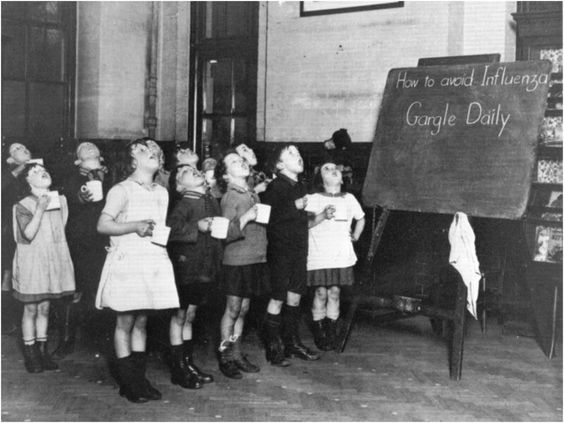The influenza epidemic of 1918 may well be the greatest scourge ever to afflict humanity, exacting a death toll greater than all the wars of the 20th Century combined. The virus that wrecked this havoc apparently developed in birds, and then jumped to people. In other words, it was avian flu. David L. Katz
The Spanish Flu
In October of 1918, the U.S. had been active in WW1 for quite a while. As they fought bravely overseas, a silent but deadly killer was making its way into America, and no one saw it coming. It would grip us in a hold that would cause death and destruction wherever it went, and leave many families devastated by the lost of one or more members.
It would close schools, theaters, and almost all public places would shut their doors. People’s lives would be capsized for more than a year, and normal living would never be the same.
What was this predator lurking on the horizon, the Spanish Flu. The month of October alone would see 195,000 Americans die due to this disease. WW1 would claim an estimated 16 million lives, but this horrible affliction would claim many more. One Fifth of the world’s population would be invaded by this virus.
How did the Spanish Flu come about putting its grip on the U.S. and the world, no one is sure. Was it from men returning home from Europe and bringing it with them or was it mutating right here at home, we will never be sure. In January 1918, a doctor in Kansas, reported unusual flu activity to the U.S. Public Health Service, and in March, at Fort Riley, an Army private would report to sick call with symptoms of fever, sore throat, and headache. Later in that same day by lunch, more than 100 soldiers would be in sick bay also reporting some of the same symptoms. With that happening there, some of the soldiers would carry this virus to other bases, and eventually overseas.
In Europe it was first called “three day fever” because it was not as strong as it would be on the second, and third wave. With just the seasonal flu, the virus only attaches to the upper respiratory tract, but with this variety it also settled in the lower respiratory tract which was easily spread, and much more deadly. With this strain doctors would notice lung tissue that was filling up with fluid, and hemorrhages. Not sure exactly what they were dealing with, some patients were misdiagnosed. Doctors at the time told them to use aspirin with a dosage of up to 30 grams, which is a toxic dose, and many got aspirin poisoning, and died.
Since the Black Plague, nothing had hit the world so hard. With the world seeing another such pandemic right now, I fear we took nothing away from that epidemic, that would ensure us of being prepared for the disaster we now are facing.
Second Wave

In July of 1918, overseas, and at home we thought the virus was being contained, and a British medical journal at the time publish an article citing that the “influenza has completely disappeared.” This was to be the understatement of the century.
In September of that same year, at Camp Devens in Massachusetts, 1543 soldiers were sent to the hospital diagnosed with the Spanish Flu in just one day. Instead of being over, this virus was gaining speed, and spreading fast. A doctor at Camp Devens announced that after a few hours of being admitted to the hospital, patients would begin turning blue, from low oxygen, and shortly pass away. Patients would either succumb quickly, or linger for just a few days, literally drowning from the fluid buildup in their lungs.

With this type of disease, usually the young wasn’t affected as bad, but this epidemic was hitting them harder, along with the elderly and small children. The flu affected over 25 percent of the U.S. population. With Covid hitting us hard right now, it seems as if we learned no lessons on how to protect the population any better now.
In a statement from the{ National Archives.gov Home,} it stated that “It is an oddity of history that the influenza epidemic of 1918 has been overlooked in the teaching of American history.” It seems in my mind that when something as terrible as this epidemic was, we just forget, learn no lessons and move on. I guess people as a whole think that it will never happen again, I guess that is what the people in 1918 thought too. Were they wrong? Will we be wrong?
Precautions and Shortages
With Covid right now, we have seen a shortage of nurses, doctors, hospital beds, respirators, hospitals, hospital supplies, and the absurd items such as toilet paper, water, and cleaning supplies. This is not so far from what they saw in 1918. They had severe nurse shortages, medicine, and hospital beds. If a family was all down with this flu they were asked to shelter in home and tend to each other, or wait for someone from the Red Cross to come by and visit, and bring supplies. Many passed away at home, and burial had to be delayed because the undertakers could not keep up with the business they had, and the deceased might have to be buried in a mass grave to conserve ground space.


Each day as the epidemic grew, new ideas, and practices would be tried to help rid the population of this menace. Here are some of the practices they put in place to slow the spread.
- 1.Close Public Schools
- 2.Close all theaters
- 3.Close all churches [ although many still tried to hold services]
- 4. Large public funerals were discouraged
- 5. Any place where large gatherings are held must close
- 6. All dance halls closed
- 7. All saloons and soda fountains are ordered to wash every glass and dish with boiling water. If rules not followed then business will be closed.
Also at the time an anti-spitting law went into effect, supervised by the police department and sanitary inspectors. People were advised to shop early in the day, and if you usually rode a trolley the rule was that only one person to a seat, and if you live in walking distance you must walk.
What kind of preventative measures did the people follow when trying to be clean and stay healthy, they didn’t have hand sanitizer back then. Here are the measures they took. Make sure to have nourishing meals, more fats and liquids, and less salt, so as to not build up extra fluid in the body. Get long hours of sleep and rest more. Make sure you keep your body clean, and have a clean environment. Clean up your yard, and burn all combustible materials. Germs hide everywhere. Drain stagnant pools, because germs hide in the filth of standing water, and create breeding grounds for diseases. Lastly cooperate with the street cleaning service of the Board of Health and this preventative cure is my favorite.
The Onion Preventative: “A farmer in Minnesota declares onions saved his family from the influenza and next year he proposes to put in 10 acres to guard against a recurrence of the epidemic. Living far from a doctor where he resided,all members of his family luxuriated in onion poultices, onion broth,onion syrup, fried onions, baked onions, and boiled onions. They were all saved from this awful disease.”[ This was from The Herald-Advance in Milbank, S.D. Nov 29,1918] I’m not sure if it was the onions or if it was because they all stayed at home away from others.



Hospitals and beds were in short supply so anyplace with a dry open space would become a makeshift hospital. Mayors with big houses would open them up to service the sick, a state armory, and YMCAs were used. In factories that was still engaged with making items for the war, any accidents, and emergency cases of a surgical nature was to be handled by the factory doctor. Everyplace and anyplace was used to combat this disease. People were asked to wear masks all the time, in and out of public, and slowly the Influenza, in its third wave was starting to wain.
At the Finish Line
The Spanish Flu started in early 1918 and lasted till early 1920. In this time frame the world had endured a medical disaster, that took far to many lives, and changed people’s way of living. The virus in 1920, was slowly losing strength because it had reached a point at which it was unable to successfully find enough hosts to catch it, then spread it. This is a lesson we need to learn, so until we all follow the rules, get vaccinated and not go into large crowds, we might never see our end of the virus.
It is said that there were approximately 675,000 American deaths from the Spanish Flu, and really this is just a guess because of inconsistent limited data. Right now we are closing in on that number and rising at 610,425.
What lessons should we have learned? Be prepared. Don’t get caught like they did in 1918, with little knowledge of the virus. Have medical supplies stockpiled. Encourage young people to become nurses and doctors. Get your vaccines when needed and follow the rules set forth to keep us safe. Hopefully by 2022 we will be at the finish line.
Thank you for reading my blog. I hope you have enjoyed it and learned something new. May we have learned our lesson, and not let history repeat itself. I would love to hear your comments so drop me a line and give me your feedback. Till next week Be Safe!!
